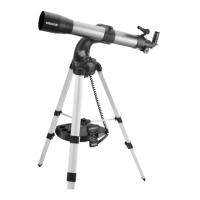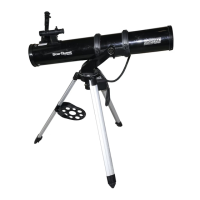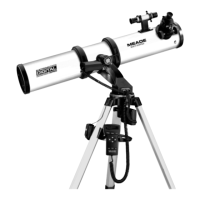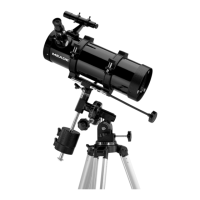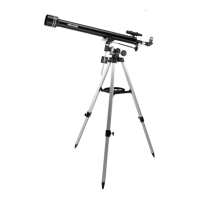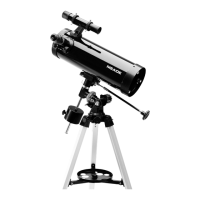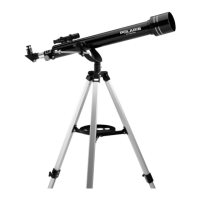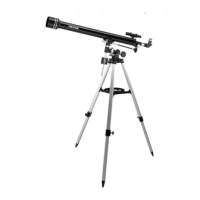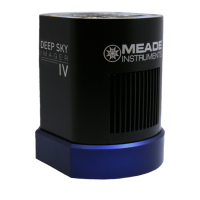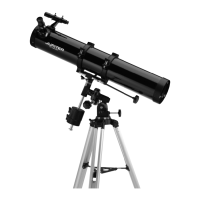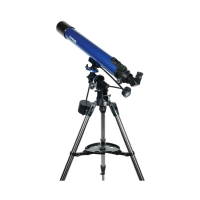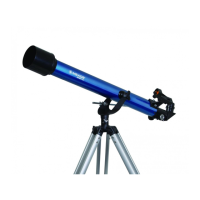Do you have a question about the Meade DS-2000 Series and is the answer not in the manual?
Lists all components included in the telescope's packaging for initial setup and verification.
Step-by-step instructions for physically assembling the telescope and mounting it on the tripod.
Description of the red dot viewfinder and its purpose in locating celestial objects easily.
Procedure for aligning the red dot viewfinder with the main telescope for accurate pointing.
Guidance on selecting eyepieces based on focal length to achieve desired magnification levels.
Explanation of how a Barlow lens multiplies eyepiece power, doubling or tripling magnification.
Instructions for manually aiming and focusing the telescope on terrestrial or celestial objects.
Tips for using the telescope for viewing distant land objects, focusing on image quality.
Guide to using the Autostar handbox arrow keys for precise telescope movement and object centering.
Details nine available slew speeds for controlling telescope movement speed and precision.
Guidance on viewing the Moon, including optimal phases and the use of filters.
Overview of the telescope's capabilities for astronomical observation and its optical performance.
Explanation of how to set up the telescope to automatically follow celestial objects as Earth rotates.
Procedure for setting the telescope's initial orientation and position for proper operation.
Guide to navigating the Autostar interface using its keys and menu structure.
Step-by-step process to set up Autostar for the first time, including location and date settings.
Demonstrates using Autostar to find and track a star, highlighting automatic tracking.
The fastest method to align the telescope using Autostar's database and two alignment stars.
Detailed steps for performing the Easy Align procedure, ensuring accurate telescope pointing.
Alignment method requiring knowledge of bright stars for precise pointing.
Alignment method relying on one known star, dependent on accurate home position.
Exercise demonstrating how to select and slew to a celestial object like Saturn.
Utilizing Autostar's guided tour feature to explore pre-selected celestial objects.
A practical exercise to understand Autostar's menu structure and functions, like calculating sunset time.
Accesses databases of celestial objects like planets, stars, nebulae, and galaxies for slewing.
Provides access to astronomical event data such as sunrise, moon phases, and meteor showers.
Alphabetical listing of definitions for astronomical terms and Autostar functions.
Offers access to features like a countdown timer, alarm, and eyepiece calculation.
Instructions and procedures for maintaining the optical alignment of the telescope for optimal performance.
Explanation of the celestial coordinate system (Right Ascension and Declination) for locating objects.
Guidance on using the Big Dipper to find Polaris and orient the telescope towards North.
Procedure for entering custom celestial object coordinates into Autostar's database.
Steps to prepare the telescope and use Autostar to track and observe satellite passes.
Procedure to train telescope motors using Autostar for improved pointing accuracy.
Instructions for replacing the batteries in the red dot viewfinder and the internal clock.
Step-by-step guide for manually setting the telescope's date via the Autostar controller.
Details the functions and operation of the Electronic Controller for EC model telescopes.
Explains the four available slew speeds for the Electronic Controller and their uses.
Lists all components included in the telescope's packaging for initial setup and verification.
Step-by-step instructions for physically assembling the telescope and mounting it on the tripod.
Description of the red dot viewfinder and its purpose in locating celestial objects easily.
Procedure for aligning the red dot viewfinder with the main telescope for accurate pointing.
Guidance on selecting eyepieces based on focal length to achieve desired magnification levels.
Explanation of how a Barlow lens multiplies eyepiece power, doubling or tripling magnification.
Instructions for manually aiming and focusing the telescope on terrestrial or celestial objects.
Tips for using the telescope for viewing distant land objects, focusing on image quality.
Guide to using the Autostar handbox arrow keys for precise telescope movement and object centering.
Details nine available slew speeds for controlling telescope movement speed and precision.
Guidance on viewing the Moon, including optimal phases and the use of filters.
Overview of the telescope's capabilities for astronomical observation and its optical performance.
Explanation of how to set up the telescope to automatically follow celestial objects as Earth rotates.
Procedure for setting the telescope's initial orientation and position for proper operation.
Guide to navigating the Autostar interface using its keys and menu structure.
Step-by-step process to set up Autostar for the first time, including location and date settings.
Demonstrates using Autostar to find and track a star, highlighting automatic tracking.
The fastest method to align the telescope using Autostar's database and two alignment stars.
Detailed steps for performing the Easy Align procedure, ensuring accurate telescope pointing.
Alignment method requiring knowledge of bright stars for precise pointing.
Alignment method relying on one known star, dependent on accurate home position.
Exercise demonstrating how to select and slew to a celestial object like Saturn.
Utilizing Autostar's guided tour feature to explore pre-selected celestial objects.
A practical exercise to understand Autostar's menu structure and functions, like calculating sunset time.
Accesses databases of celestial objects like planets, stars, nebulae, and galaxies for slewing.
Provides access to astronomical event data such as sunrise, moon phases, and meteor showers.
Alphabetical listing of definitions for astronomical terms and Autostar functions.
Offers access to features like a countdown timer, alarm, and eyepiece calculation.
Instructions and procedures for maintaining the optical alignment of the telescope for optimal performance.
Explanation of the celestial coordinate system (Right Ascension and Declination) for locating objects.
Guidance on using the Big Dipper to find Polaris and orient the telescope towards North.
Procedure for entering custom celestial object coordinates into Autostar's database.
Steps to prepare the telescope and use Autostar to track and observe satellite passes.
Procedure to train telescope motors using Autostar for improved pointing accuracy.
Instructions for replacing the batteries in the red dot viewfinder and the internal clock.
Step-by-step guide for manually setting the telescope's date via the Autostar controller.
Details the functions and operation of the Electronic Controller for EC model telescopes.
Explains the four available slew speeds for the Electronic Controller and their uses.
